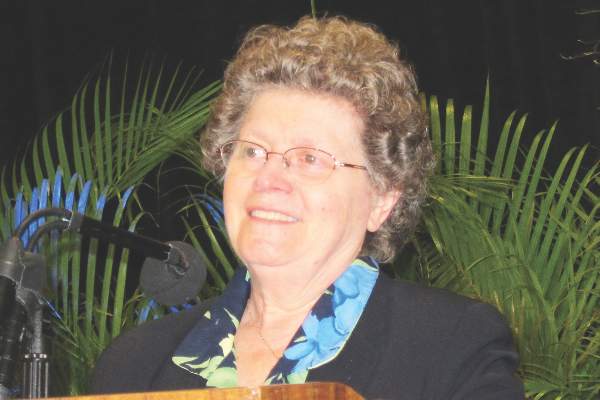User login
MAUI, HAWAII – Multiple studies have firmly established that the traditional Framingham Risk Score seriously underestimates the substantially increased risk of coronary artery disease present in patients with systemic lupus erythematosus (SLE). Nor is the American College of Cardiology/American Heart Association atherosclerotic cardiovascular disease risk score reliable in this population. But now physicians at the University of Toronto Lupus Clinic have come up with a more accurate risk prediction tool.
The new score is a straightforward modification of the Framingham Risk Score (FRS). It is calculated by multiplying the values for the items included in the classic FRS by two. It’s called, simply enough, the 2FRS, Dr. Dafna D. Gladman explained at the 2016 Rheumatology Winter Clinical Symposium.
In developing the 2FRS, she and her coinvestigators didn’t change the relative values of the individual components of the standard FRS. Instead, they calculated the standard baseline FRS values for 905 women with SLE who were prospectively followed at the Toronto Lupus Clinic. None had a prior history of CAD or diabetes when they enrolled in the cohort. Then the investigators tried multiplying those scores by 1.5, 2, 3, and 4 to learn which multiplier yielded the best sensitivity and specificity for prediction of coronary events, which occurred in 95 women during follow-up. Doubling the classic FRS score turned out to be the clear winner, according to Dr. Gladman, professor of medicine and codirector of the University of Toronto Lupus Clinic.
The classic FRS categorized 2.4% of the patients as being at moderate or high cardiovascular risk. With the 2FRS, this figure climbed to 17.3%. In a time-dependent covariant analysis for prediction of the first coronary event, a moderate/high score on the classic FRS was associated with a 3.2-fold increased risk, while a moderate/high score on the 2FRS conferred a 4.4-fold increased risk (J Rheumatol. 2016 Feb 15. doi: 10.3899/jrheum.150983).
The reason the classic FRS underestimates the true risk of atherosclerotic vascular events in lupus patients was illustrated in an earlier study by the Toronto group. Among 1,087 patients with no history of cardiovascular disease or diabetes when they enrolled at the clinic, 10.9% went on to experience an atherosclerotic vascular event during follow-up. In a multivariate analysis, disease-specific risk factors – namely, the presence of vasculitis or neuropsychiatric findings – proved to be more potent predictors of subsequent atherosclerotic vascular events than did the number of FRS risk factors or smoking status (J Rheumatol. 2007 Jan;34[1]:70-5).
It has long been known that mortality in SLE patients follows a bimodal pattern. Premature cardiovascular deaths explain a large portion of the second peak.
“In our total Toronto SLE cohort, we find there’s a fivefold increased risk for the development of acute MI compared to controls. The average age at which MI occurs is 69 for women in the general population, but it’s 49 for women in our lupus cohort,” according to Dr. Gladman.
In yet another study focusing on atherosclerotic comorbidity in lupus patients, the Toronto group showed that carotid total plaque area as measured by high-resolution ultrasound correlated significantly better – by nearly fivefold – with clinical ischemic cardiovascular events than did carotid intima-media thickness, suggesting total plaque area may be the better tool for investigating atherosclerotic vascular disease as expressed in SLE patients. Carotid plaque also displayed a much stronger correlation with conventional cardiovascular risk factors, including hypertension and elevated LDL cholesterol, in the lupus patients (Lupus. 2014 Oct;23[11]:1142-8).
Dr. Gladman reported receiving research grants from GlaxoSmithKline and Janssen and serving as a consultant to those pharmaceutical companies as well as to Bristol-Myers Squibb and UCB.
MAUI, HAWAII – Multiple studies have firmly established that the traditional Framingham Risk Score seriously underestimates the substantially increased risk of coronary artery disease present in patients with systemic lupus erythematosus (SLE). Nor is the American College of Cardiology/American Heart Association atherosclerotic cardiovascular disease risk score reliable in this population. But now physicians at the University of Toronto Lupus Clinic have come up with a more accurate risk prediction tool.
The new score is a straightforward modification of the Framingham Risk Score (FRS). It is calculated by multiplying the values for the items included in the classic FRS by two. It’s called, simply enough, the 2FRS, Dr. Dafna D. Gladman explained at the 2016 Rheumatology Winter Clinical Symposium.
In developing the 2FRS, she and her coinvestigators didn’t change the relative values of the individual components of the standard FRS. Instead, they calculated the standard baseline FRS values for 905 women with SLE who were prospectively followed at the Toronto Lupus Clinic. None had a prior history of CAD or diabetes when they enrolled in the cohort. Then the investigators tried multiplying those scores by 1.5, 2, 3, and 4 to learn which multiplier yielded the best sensitivity and specificity for prediction of coronary events, which occurred in 95 women during follow-up. Doubling the classic FRS score turned out to be the clear winner, according to Dr. Gladman, professor of medicine and codirector of the University of Toronto Lupus Clinic.
The classic FRS categorized 2.4% of the patients as being at moderate or high cardiovascular risk. With the 2FRS, this figure climbed to 17.3%. In a time-dependent covariant analysis for prediction of the first coronary event, a moderate/high score on the classic FRS was associated with a 3.2-fold increased risk, while a moderate/high score on the 2FRS conferred a 4.4-fold increased risk (J Rheumatol. 2016 Feb 15. doi: 10.3899/jrheum.150983).
The reason the classic FRS underestimates the true risk of atherosclerotic vascular events in lupus patients was illustrated in an earlier study by the Toronto group. Among 1,087 patients with no history of cardiovascular disease or diabetes when they enrolled at the clinic, 10.9% went on to experience an atherosclerotic vascular event during follow-up. In a multivariate analysis, disease-specific risk factors – namely, the presence of vasculitis or neuropsychiatric findings – proved to be more potent predictors of subsequent atherosclerotic vascular events than did the number of FRS risk factors or smoking status (J Rheumatol. 2007 Jan;34[1]:70-5).
It has long been known that mortality in SLE patients follows a bimodal pattern. Premature cardiovascular deaths explain a large portion of the second peak.
“In our total Toronto SLE cohort, we find there’s a fivefold increased risk for the development of acute MI compared to controls. The average age at which MI occurs is 69 for women in the general population, but it’s 49 for women in our lupus cohort,” according to Dr. Gladman.
In yet another study focusing on atherosclerotic comorbidity in lupus patients, the Toronto group showed that carotid total plaque area as measured by high-resolution ultrasound correlated significantly better – by nearly fivefold – with clinical ischemic cardiovascular events than did carotid intima-media thickness, suggesting total plaque area may be the better tool for investigating atherosclerotic vascular disease as expressed in SLE patients. Carotid plaque also displayed a much stronger correlation with conventional cardiovascular risk factors, including hypertension and elevated LDL cholesterol, in the lupus patients (Lupus. 2014 Oct;23[11]:1142-8).
Dr. Gladman reported receiving research grants from GlaxoSmithKline and Janssen and serving as a consultant to those pharmaceutical companies as well as to Bristol-Myers Squibb and UCB.
MAUI, HAWAII – Multiple studies have firmly established that the traditional Framingham Risk Score seriously underestimates the substantially increased risk of coronary artery disease present in patients with systemic lupus erythematosus (SLE). Nor is the American College of Cardiology/American Heart Association atherosclerotic cardiovascular disease risk score reliable in this population. But now physicians at the University of Toronto Lupus Clinic have come up with a more accurate risk prediction tool.
The new score is a straightforward modification of the Framingham Risk Score (FRS). It is calculated by multiplying the values for the items included in the classic FRS by two. It’s called, simply enough, the 2FRS, Dr. Dafna D. Gladman explained at the 2016 Rheumatology Winter Clinical Symposium.
In developing the 2FRS, she and her coinvestigators didn’t change the relative values of the individual components of the standard FRS. Instead, they calculated the standard baseline FRS values for 905 women with SLE who were prospectively followed at the Toronto Lupus Clinic. None had a prior history of CAD or diabetes when they enrolled in the cohort. Then the investigators tried multiplying those scores by 1.5, 2, 3, and 4 to learn which multiplier yielded the best sensitivity and specificity for prediction of coronary events, which occurred in 95 women during follow-up. Doubling the classic FRS score turned out to be the clear winner, according to Dr. Gladman, professor of medicine and codirector of the University of Toronto Lupus Clinic.
The classic FRS categorized 2.4% of the patients as being at moderate or high cardiovascular risk. With the 2FRS, this figure climbed to 17.3%. In a time-dependent covariant analysis for prediction of the first coronary event, a moderate/high score on the classic FRS was associated with a 3.2-fold increased risk, while a moderate/high score on the 2FRS conferred a 4.4-fold increased risk (J Rheumatol. 2016 Feb 15. doi: 10.3899/jrheum.150983).
The reason the classic FRS underestimates the true risk of atherosclerotic vascular events in lupus patients was illustrated in an earlier study by the Toronto group. Among 1,087 patients with no history of cardiovascular disease or diabetes when they enrolled at the clinic, 10.9% went on to experience an atherosclerotic vascular event during follow-up. In a multivariate analysis, disease-specific risk factors – namely, the presence of vasculitis or neuropsychiatric findings – proved to be more potent predictors of subsequent atherosclerotic vascular events than did the number of FRS risk factors or smoking status (J Rheumatol. 2007 Jan;34[1]:70-5).
It has long been known that mortality in SLE patients follows a bimodal pattern. Premature cardiovascular deaths explain a large portion of the second peak.
“In our total Toronto SLE cohort, we find there’s a fivefold increased risk for the development of acute MI compared to controls. The average age at which MI occurs is 69 for women in the general population, but it’s 49 for women in our lupus cohort,” according to Dr. Gladman.
In yet another study focusing on atherosclerotic comorbidity in lupus patients, the Toronto group showed that carotid total plaque area as measured by high-resolution ultrasound correlated significantly better – by nearly fivefold – with clinical ischemic cardiovascular events than did carotid intima-media thickness, suggesting total plaque area may be the better tool for investigating atherosclerotic vascular disease as expressed in SLE patients. Carotid plaque also displayed a much stronger correlation with conventional cardiovascular risk factors, including hypertension and elevated LDL cholesterol, in the lupus patients (Lupus. 2014 Oct;23[11]:1142-8).
Dr. Gladman reported receiving research grants from GlaxoSmithKline and Janssen and serving as a consultant to those pharmaceutical companies as well as to Bristol-Myers Squibb and UCB.
EXPERT ANALYSIS FROM RWCS 2016

